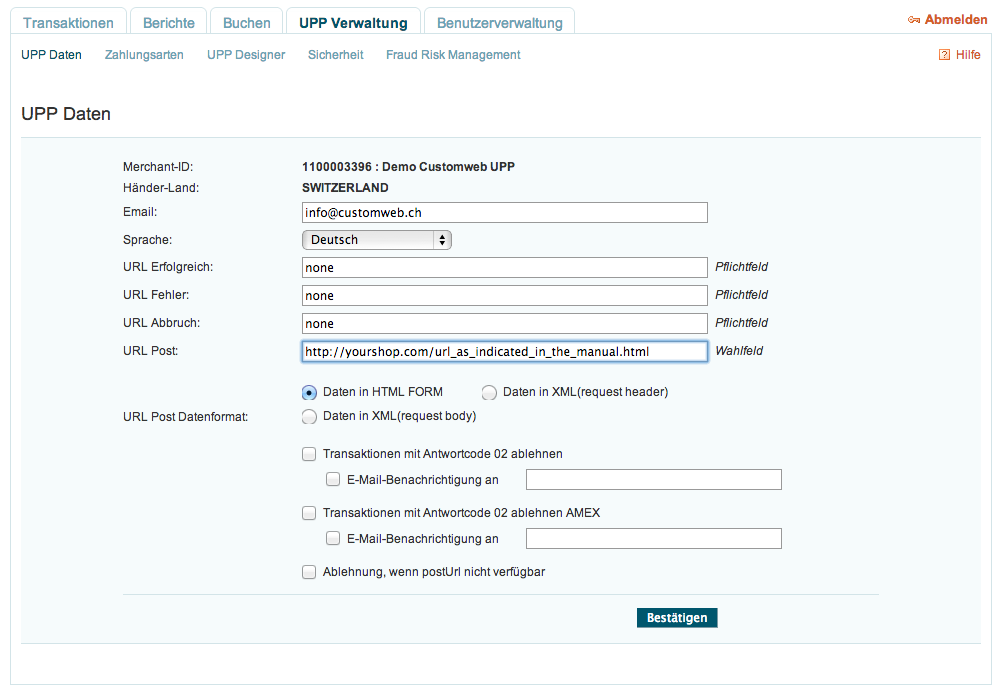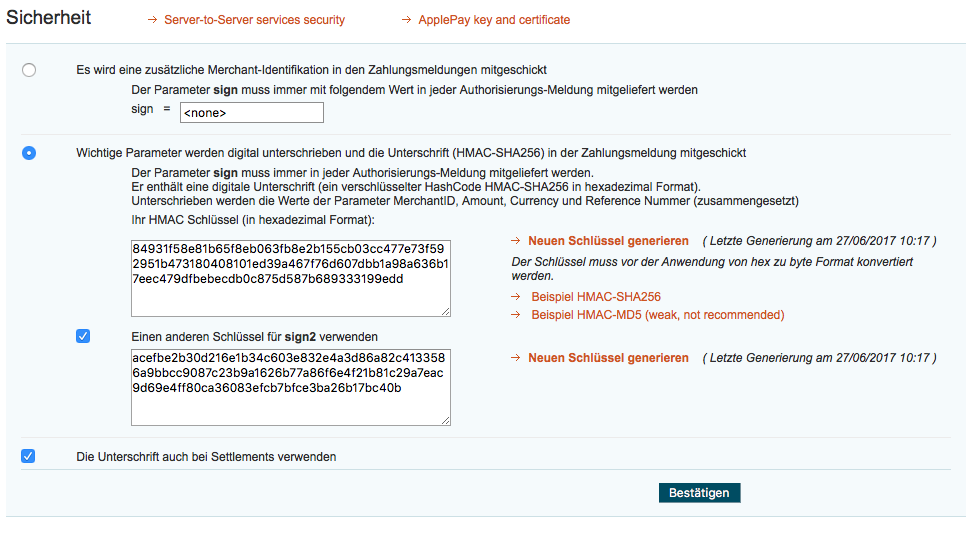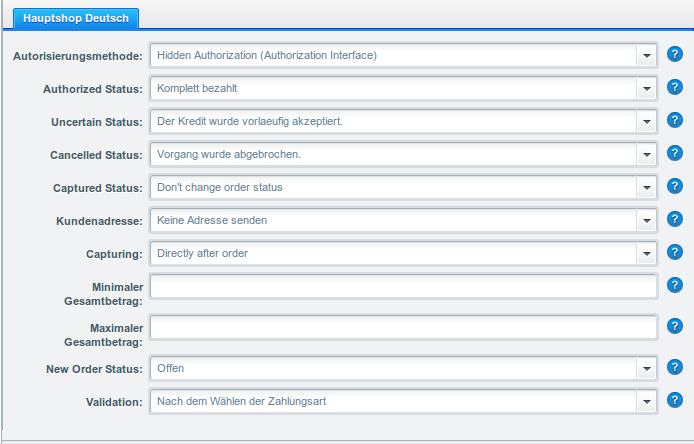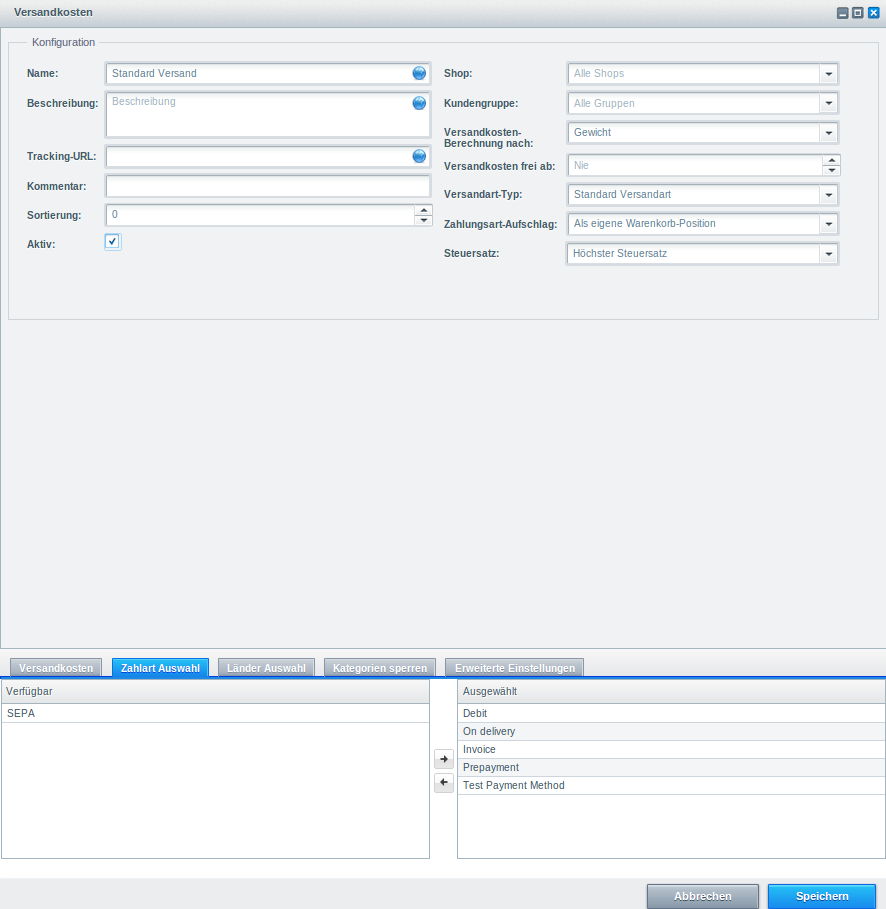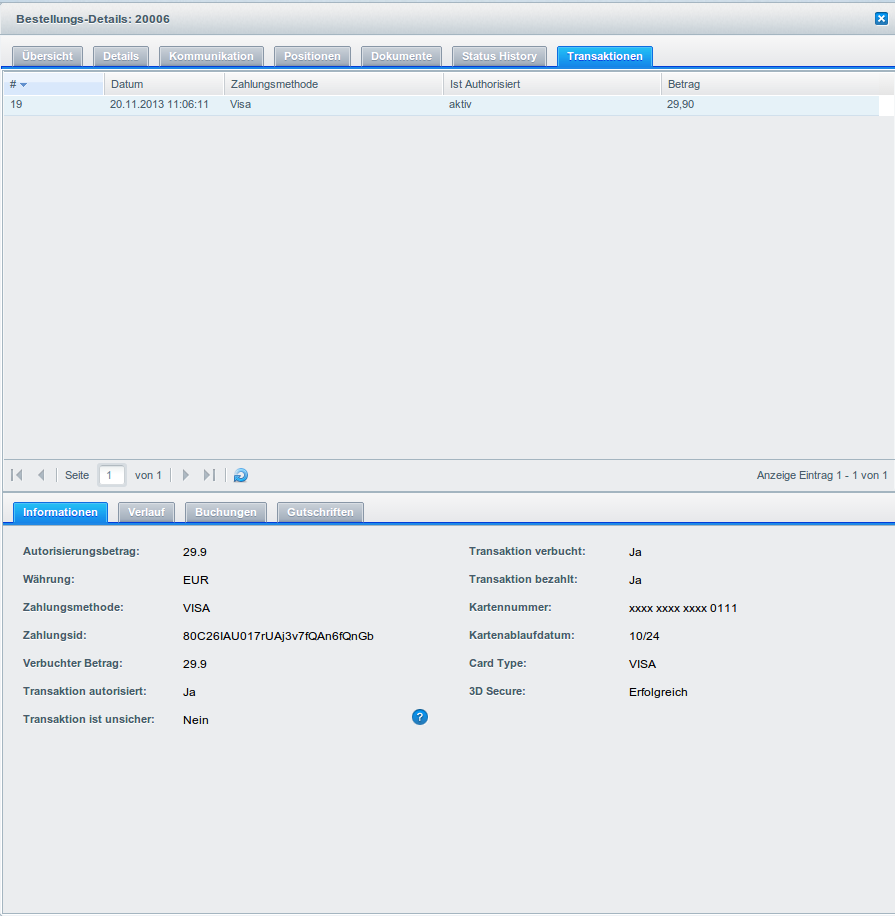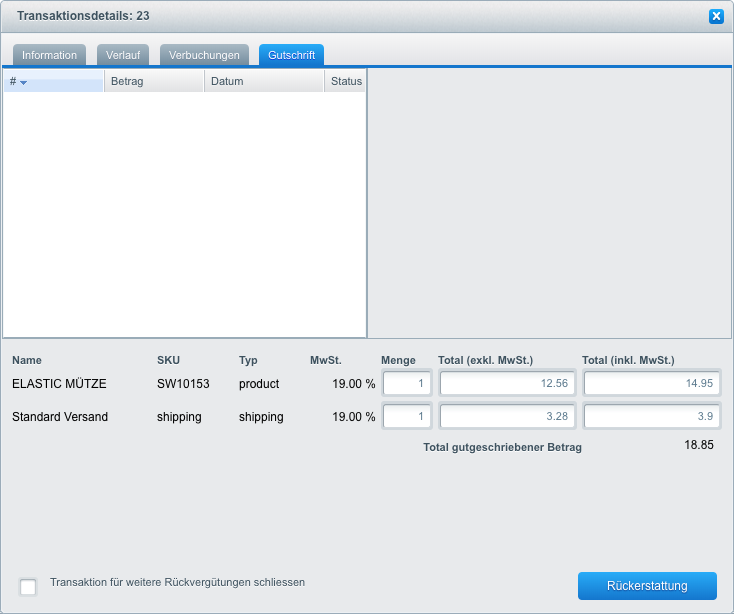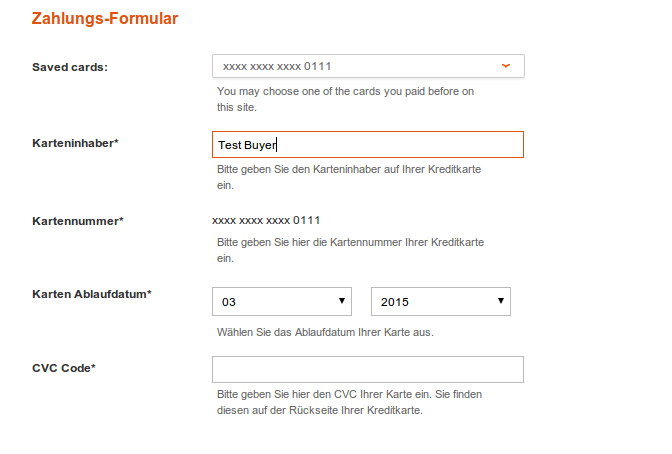1Introduction
This manual explains the installation, configuration and usage of the payment module for Shopware and Datatrans.
Before beginning with the installation, please make sure that you are in possession of all necessary data:
- You should have received a Merchant ID from Datatrans for the test account (beginning with 1xxxxxxxx) as well as a Merchant ID for the live account (beginning with 3xxxxxxxx). Furthermore, you have received the corresponding user name and password
- Shopware payment module by sellxed.com/shop
- Access data to your server and shop
In case you don't yet have a contract with Datatrans, you can gladly acquire it directly through us.
Note that you must use at least PHP version 5.6 for our plugins. PHP 8 or higher is currently not supported.
1.1Procedure of the Installation
In this document you will find all important information for the installation of the module. It is important that you strictly follow the checklist. Only by doing so, can a secure usage in correspondence with all security regulations be guaranteed.
- Configuration of the test administrative interface of Datatrans. You can find the test platform under https://admin.sandbox.datatrans.com/
- Configuration of the basic settings of the payment module
- Configuration of the payment methods
- Carrying out of a test purchase by means of the attached test data at the end of this document
- If the test was successful, copy all data of your test account into the live account of Datatrans. The live environment can be found under the following URL: https://admin.datatrans.com/
Our payment plugins should have per default the correct settings for most of our customers' preferences. That means once you have entered the required credentials in the plugin configuration to connect your account to your website, the plugin should be fully operational. Should you be willing to receive detailed information on a setting you do not know, you may contact our support team who will be able to assist you further.
Our support team is at your disposal during regular business hours at: http://www.sellxed.com/support. Furthermore, you have the option of ordering our installation service. We will make sure the plugin is installed correctly in your shop: http://www.sellxed.com/shop/de/integration-und-installation.html
In order to test the module, any kind of directory protection or IP blocking on your server must be deactivated. This is crucial as otherwise the payment feedback of Datatrans might not get through to the shop.
1.2System Requirements
In general, the plugin has the same system requirements as Shopware. Below you can find the most important requirements of the plugin:- PHP Version: 5.4.x or higher
- OpenSSL: Current version with support for TLS 1.2 or higher.
- fsockopen: The PHP function fsockopen must be enabled. The plugin must be able to connect to external systems over the Internet.
- PHP Functions: All common PHP functions must be enabled.
2Configuration Datatrans - Backend
For the configuration, log into Datatrans in the Payment Web Administration Tool:
- Test Environment: https://admin.sandbox.datatrans.com/
- Live Environment: https://admin.datatrans.com/
The settings carried out on the following pages are a precondition for the later configuration of the main module.
2.1Configuration - UPP Administration
Under UPP Administration the settings for the feedback of Datatrans to the shop are defined.
The configuration of the feedback-URL plays a central role in the configuration of the module. Should the saved URLs not be correct, no feedback is returned to your shop. This leads to the payment not being processed correctly.
URL Successful, URL Failed, URL Cancel are all transmitted by our module. For this reason, enter none into the boxes.
For the Transaction Feedback please enter the URL that is generated in the main module. More information can be found under the section Transaction Feedback
Make sure that you did not tick the option "Cancel payment when Post-URL not available" and "Decline transaction with response code 02".
As an illustration we have added a screenshot:
2.2Security - Configuration of the Sign-Parameters
The sign parameters are required in order to ensure the authenticity of the communication between Datatrans and your shop. It is not necessary to define the sign parameters, however, we strongly recommend carrying out the following settings.
Choose the HMAC-SHA256 Algorithm for the signature. By clicking on generate new key, a new sign will automatically be created. Enter this sign into the respective box within the main module and note it in a text file. You will require it for the later configuration.
We also recommend using a different sign2-key. Click on generate new key and note it down or copy it into the sign2-box in the main module.
Furthermore, we recommend ticking Also sign settlement requests.
As an illustration, please see the screenshot:
2.3Security - Activation of the IP Whitelisting
We support the IP whitelisting option as authentication method to Datatrans. (Server-to-server protection with password we don't support)
To do this, remove the "Protect server-to-server services with password" option and enable the "Enable IP whitelist protection (legacy APIs)" option.
Then, in the "Permitted IP addresses" field, add the IP addresses of your shop/server that communicates with Datatrans:
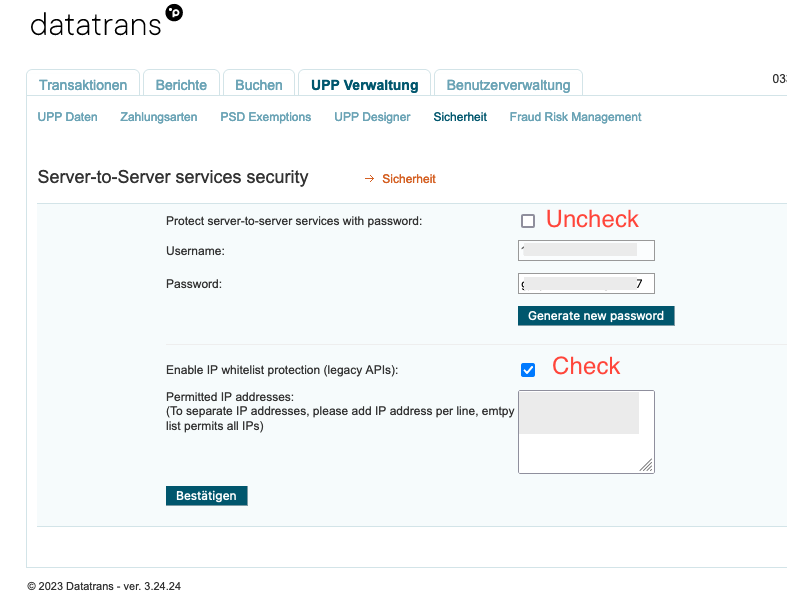
2.4Fraud Risk Management
Under the tab Fraud Risk Management you can exclude certain countries of origin of credit cards due to their risk management of payments. In this case, these credit cards will be refused by authorisation process of Datatrans.
2.5Transactions
In the tab Transactions you can find an overview of effected transactions. You can authorise, debit or refund them directly. However, due to the integrated transaction manager of in all sellxed payment modules, you can also do this directly from within the shop. Caution: If you debit payments here then the status is not synchronised with the shop. A renewed debiting in the shop will fail.
3Module Installation and Update in the Shopware Shop
3.1Installation
At this time you should already be in possession of the module. Should this not be the case, you can download the necessary files in your customer account in the sellxed shop (Menu "My Downloads Downloads"). In order to install the module in your shop, please carry out the following steps:
- Download the plugin. The download can be found in your sellxed.com account under "My Downloads".
- Unzip the archive you have just downloaded.
- In the unzipped folder navigate to the folder "files"
- For some shops there are different versions of the plugin provided. If this is the case open the folder which corresponds to your shop version.
- Using your preferred FTP client upload entire content of this folder into the root directory of your shop. For some shops there is a specific folder containing the plugins. If that is the case upload the plugin into this folder. Make sure that the folders aren't replaced but merely merged.
- If you haven't yet done so, log back into your shop.
3.2Updates and Upgrades
You have direct and unlimited access to updates and upgrades during the duration of your support contract. In order to receive constant information about available updates we ask you to subscribe to our RSS feed that we publish for your module.
More information regarding the subscription of this RSS feed can be found under: http://www.sellxed.com/en/updates_upgrades.
We only recommend an update if something doesn't work in your shop, if you want to use new feature or if there is a necessary security update.
3.2.1Update Checklist
We ask you to strictly comply with the checklist below when doing an update:
- Always do a backup for your database and your files in your shop
- Use always a test system to test the update process.
- Wait until all the files are copied to the shop, clear the cache if there is one in your shop and then visit the configuration page of the main module so that the update process will be initialized.
Please test the update procedure first in your test shop. Our support team is able and willing to help you if you experience problems with the update process. However, if you decide to perform the update directly in your live shop there is the possibility of a downtime of the shop of more than two days depending on the availability of our support if you do not want to book our complementary support.
Depending on the version it could be that the database has to be migrated. We recommend you therefore, to perform the updates in times when the shop is not visited too frequently by your customers.
3.2.2Update Instructions
Please always read the update instruction. Those instructions can be found in the changelog. If there are no special remarks, you can proceed by just overwriting the files in your system.
3.2.3Updated Plugin from the DatatransCw to the CwbDatatransCw Version.
We plan to release this plugin in the shopware store in the near future. To make this possible we hda to apply some changes to our code. Most important a prefix for our PHP classes is required and the plugin folder had to be renamed. To update to this new version simply overwriting the existing files is not possible. This sections describes the steps required to update the module in detail.
Please test the update procedure first in your development system. So you can ensure the update is working correctly.
If you are using multiple plugins from us. You need to update all of them to the new version.
- Activate the maintenance mode of the shop.
- Make a backup for your database and your files in your shop. Without this you will not be able to revert to the old version, if anything goes wrong.
- Upload the new plugin files.
- Deactivate the existing plugin. Do not deinstall the old plugin yet.
- Install and activate the new plugin.
- If you have custom css or template files for the plugin, adapt the changes to the new plugin.
- If you are using the Shopware API endpoint of this plugin, update the URL to new endpoint.
- Verify the main and method settings.
- Deinstall the old plugin.
- Delete the files of the old plugin. The following files/folders must be removed, if they exist:
- engine/Shopware/Plugins/Local/Frontend/DatatransCw
- engine/Library/Customweb
- engine/Library/Crypt
- engine/Library/File
- engine/Library/Math
- engine/Library/Mobile
- engine/Library/Net
- engine/Library/PhoneNumber
- engine/Library/System
- engine/Library/loader.php
- engine/Library/openssl.cnf
- Make a test transaction to verify everything is workin correctly.
- Deactive the maintenance mode of the shop.
4Module Configuration in the Shopware Shop
The configuration consists of two steps. The first step is the configuration of the main module with all the basic settings (cf. Configuration of the Main Module). During the second step you can then carry out individual configurations for each payment method . This allows for full flexibility and perfect adaptation to your processes.
Please create a backup of the main directory of your shop. In case of problems you will then always be able to return your shop to its original state.
We furthermore recommend testing the integration on a test system. Complications may arise with third party modules installed by you. In case of questions, our support is gladly at your disposal.
4.1Configuration of the Main Module
In order to install the main module search for Datatrans under Settings > Plugin Manager . Click on the + symbol in order to begin the installation process. Afterwards, click the "edit" symbol and configure the main module.
Enter the individual options which you partly may have already used for the configuration of the administration interface of Datatrans. Should an option not be clear to you, you can click on the question mark and will find further information on the settings.
4.2Defining the URL for the Transaction Feedback
To ensure correct payment processing in your shop, at least one Feedback URL has to be provided in the Datatrans configuration. The URL to be entered can be found in your Shopware Shop under: Configuration > Datatrans > Setup > Setup
4.3Configuration of the Payment Method
After having configured the main module, you will find all payment methods under Settings > Payment Methods. Activate each payment method you wish to offer in your shop. You can save individual settings for each payment method (and for each shop in case of a multi-shop set-up) and thereby optimally adapt the payment methods to your existing processes. The most central options are described in more detail further below.
4.4Assigning the Payment Method to the Shipping Costs
In order for the transactions and the shipping costs to be matched correctly to the payment methods you need to assign the payment methods to the shipping methods. Go to settings > shipping costs. Open all the shipping costs and add a payment method.
Depending on the amount of delivered payment methods, it may be that certain payment methods can't be attributed to a specific shipping method as not all payment methods can be displayed. This is a known bug of Shopware. Merely the first 30 payment methods are displayed. Please delete all payment methods that you don't need and then all other payments will be displayed.
4.5Direct Capturing of Transactions
The option "Capture" allows you to specify if you wish to debit payments directly or if you first wish to authorise them and then debit the payment at a later point.
Depending on your acquiring contract, a reservation is only guaranteed for a specific period of time. Should you fail to debit the payment within that period, the authorisation may therefore no longer be guaranteed. Further information on this process can be found below.
It may be that settings saved in the payment modules overwrite settings saved in Datatrans.
4.6Uncertain Status
You can specifically label orders for which the money is not guaranteed to be received. This allows you to manually control the order before shipment.
4.6.1Setting the order state
For each payment method you may select in which state the order should be set to depending on the booking state. This is the initial state of the order.
4.7Optional: Validation
Note: It can be that this option is not visible in your module. In this case just ignore this section.
With the option 'Validation' you can define the moment when the payment method should be made visible to the customer during the checkout process. This setting is relevant for modules where the usage depends on the customer's compliance with specific preconditions. For example, if a solvency check has to be carried out or if the payment method is only available in certain countries. In order for the credit check or address validation to also work with European characters, the charset of the "Blowfish mode" must be set to "UTF-8" for certain PSP settings.
You have the choice between these options:
- Validation before the selection of the payment method: A validation verification is carried out before the customer selects the payment method. If the customer does not fulfill the requirements, the payment method is not displayed
- Validation after selection of the payment method: The verification of the compliance occurs after the selection of the payment method and before the confirmation of the order
- During the authorisation: The validation verification is carried out by Datatrans during the authorisation process. The payment method is displayed in any case
4.8Defining the URL for the Transaction Feedback
To ensure correct payment processing in your shop, at least one Feedback URL has to be provided in the Datatrans configuration. The URL to be entered can be found in your Shopware Shop under:Configuration > Datatrans > Setup
4.8.1Usage of the Integrated Multishop Functionality of Shopware
The payment module supports the multishop feature of Shopware. No further modifications are necessary. The module automatically recognizes the shop the order belongs to. In order for the multishop functionality to work, it is, however, necessary that the individual sub-shops within Shopware have been configured correctly.
5Settings / Configuration of Payment Methods
5.1General Information About the Payment Methods
The plugin contains the most common payment methods. In case a desired payment method is not included per default, please contact us directly.
In order to be able to use a payment method, it must be activated in your account with Datatrans as well as in your shop. Information about the configuration of the payment methods can be found further above.
Below you can find important information for specific payment methods that deviate from the standard process.
5.2Information on Payment Status
For each payment method you can define an initial payment status (status for authorized payments etc.). You hereby define the payment status for each state depending on the processing type of the order (captured, authorized, etc.). It's the initial status which the order assumes. Depending on the mutation carried out by you, the status can change.
Never set the status to Pending Datatrans or any similar pending status which is implemented by the module.
5.2.1Order status "pending" / imminent payment (or similar)
Orders with the status 'pending Datatrans' are pending orders. Orders are set to that status if a customer is redirected in order to pay but hasn't returned successfully or the feedback hasn't reached your shop yet (Customer closed window on the payment page and didn't complete payment). Depending on the payment method these orders will automatically be transformed into cancelled orders and the inventory will be cleared (so long as the Cronjob is activated). How long this takes depends on the characteristics of the payment method and cannot be configured.
If you have a lot of pending orders it usually means that the notifications from your webserver to Datatrans are being blocked. In this case check the settings of your firewall and ask the Hoster to activate the IPs and User Agents of Datatrans.
5.2.2Order status "cancelled"
Orders with the status "cancelled" have either been set to that status automatically due to a timeout, as described above, or have been cancelled directly by the customer.
5.3OpenInvoice / Invoice via MFGroup or Swissbilling
With your Datatrans module you have now the possibility to process invoices via MFGroup (POWERPAY) or Swissbilling. To do so, activate as usual the payment method in your shop and select the the processor from the drop-down list.
Additionally you have the possibility to choose, if there should be a credit check in the background before the payment method display. And if the payment method should be hidden during a negative feedback. To be able to do so, the appropriate options have to be activated by Datatrans and the processor. Set under validation the right point in time. You have three options:
- Before the selection of the payment method: This option enables you to process the credit check before the payment method display
- After the selection of the payment method: The credit check is processed after the costumer has chosen a payment method, but didn't complete the order.
- During the authorization: This is standard. The processing happens during the authorization by your Datatrans.
6The Module in Action
Below you will find an overview of the most important features in the daily usage of the Datatrans module.
6.1Capturing / Canceling of Orders
6.1.1Capturing Orders
The transaction management between your shop and Datatrans is not synchronized. If you capture payments with Datatrans, the status in the shop will not be updated and a second capturing in the shop is not possible.
In order to be able to capture orders, you must make sure that you have set 'Capturing' to deferred in the configuration of the payment method.
Open the order you wish to capture and switch to the tab Transactions. Here you will find the tab Captures. Enter the amount you wish to debit from the customer's card. By clicking Capture, a direct capturing of the order occurs with Datatrans.
6.1.2Cancellation
By clicking the button Cancel, you delete the initial authorization on the customer's card. The pre-authorized amount is released from the customer's card.
6.2Useful Transaction Information on the Order
In each order, processed via our module, you can find an overview of the most important information about the transaction as well as a transaction history.
In order to get to the transaction information, open the order and switch to the tab Transactions. Here you will find all authorization attempts and the related information.
6.3Refunds
You can refund already captured transactions and automatically transmit them to Datatrans. In order to to so, open the order. Switch to the tab Transactions. A new window will open up in which you must then switch to the tab Refunds in order to refund orders.
To refund a line item you need to enter the quantity you wish to refund. By clicking Refund, the refund is automatically transmitted to Datatrans. It will than be refunded via the payment method the customer chose for the transaction.
Please note that you can't refund more than 100% of the original amount.
Executing a refund will not change the status of the order.
6.4Usage of the Alias Managers / Token Solution
With the Alias Manager, your customers can securely save their credit cards with Datatrans for later purchases. You can enable this by activating the option "Alias Manager" in the configuration of the Payment Method. The customer can then choose from his or her saved credit cards without having to re-enter all the details.
The usage of the Alias Managers requires the activation of the correct option with Datatrans. To do so, please contact the support directly.
7Getting the Credit Card Data via Shopware REST API
When connecting ERP systems to Shopware it may be that further information is required via Shopware API. Our module provides you with a lot of payment information also via Shopware REST API.
Basic Information about the usage of the REST API of Shopware can be found in the Shopware Developers Guide.
The service can be called up under https://www.shop-url.com/api/CwbdatatranscwTransactions. The call of the above URL leads to the listing of all transactions. By adding the Transaction ID you can filter by the corresponding Transaction ID. The Transaction ID can be found in the order overview (Customer > Payments > Datatrans )
Additionally, you can also access the transaction via the Payment ID (transmitted through Datatrans). To do so, the parameter 'usePaymentId=1' has to be added as a parameter to the URL.
8Set-up a cron job to activate the timed operations
To activate the timed operations of the plugin (e.g. update service, deleting pending orders, etc.) make sure that you set up the Shopware Cron engine. Especially the update function allows you to automatically retrieve additional information or changes of your order directly via the API of Datatrans. For payment methods which use a delayed authorisation process this is mandatory. Please note it could be that in order to use the update feature it may be necessary that Datatrans activates additional options in your account.
The module uses the standard cron engine of Shopware. More information regarding the set up can be found here: https://community.shopware.com/Cronjobs_detail_1102.html.
9Testing
Before switching from test to live mode it is important that you test the module extensively.
Do not forget to switch the operating mode from test to live after having successfully tested the module.
9.1Test Data
In the following section you can find the test data for the various payment methods:Card number 4900 0000 0000 0003 Expiry Date 12/2021 CVC 123 | Visa: With 3-D Secure Check |
Card number 5200 0000 0000 0007 Expiry Date 12/2021 CVC 123 | MasterCard: Without 3D-Secure |
Card number 5200 0000 0000 0080 Expiry Date 12/2021 CVC 123 | MasterCard: With 3D-Secure |
Card number 375000000000007 Expiry Date 12/2021 CVC 1234 | American Express: With 3D Secure |
Card number 3616 7719 110 012 Expiry Date 12/2021 CVC 123 | Diners |
Card number 3569 9900 1003 0400 Expiry Date 12/2021 CVC 123 | JCB |
Card number 6759 6498 2643 8453 Expiry Date 12/2021 CVC 123 | Maestro UK |
Card number 4900 0000 0000 0003 Expiry Date 12/2021 CVC 123 | Visa: With 3-D Secure Check |
Card number 5200 0000 0000 0007 Expiry Date 12/2021 CVC 123 | MasterCard: Without 3D-Secure |
Card number 5200 0000 0000 0080 Expiry Date 12/2021 CVC 123 | MasterCard: With 3D-Secure |
Card number 375000000000007 Expiry Date 12/2021 CVC 1234 | American Express: With 3D Secure |
Card number 3616 7719 110 012 Expiry Date 12/2021 CVC 123 | Diners |
Card number 3569 9900 1003 0400 Expiry Date 12/2021 CVC 123 | JCB |
Card number 6759 6498 2643 8453 Expiry Date 12/2021 CVC 123 | Maestro UK |
10Errors and their Solutions
You can find detailed information under http://www.sellxed.com/en/faq. Should you not be able to solve your problem with the provided information, please contact us directly under: http://www.sellxed.com/en/support
10.1The Referrer URL appears in my Analytics Tool
When a customer and the notification are redirected via Header Redirection, the Datatrans Referrer URL might appear in your Analytics Tool thus hiding the original traffic source. However, most Analytic Tools are able to minimize this problem.
In case you are using Google Analytics as reporting tool, this step by step guide may help you to exclude the URLs: under bullet point 4.
11Compatibility with Third-Party Plugins
The plugins listed below are compatible with our payment modules and allow you to handle certain tasks in an easier way.
11.1Birthday and gender in Shopware
For certain payment service providers it is necessary to check the birthday and the gender of a customer. Shopware does not check this by default. To enable these checks go to "Configuration > Basic Settings > Frontend > Login / Registration" and check the following parameters:
- Show Birthday Field
- Birthday is required
- Show "I am" select field
12Error Logging
The module will log different unexpected errors or information depending on the configured level. If there is any issue with the module, this log can help identify the cause.
12.1Log Levels
You can configure the log level in the Datatrans settings.
- Error: Logs unexpected errors only. (Default)
- Info: Logs extended information.
- Debug: Logs information helpful for debugging.
12.2Log Location
The log file is stored in the Shopware log directory. Please make sure the path exists and it is writable by the webserver. (Default Path: {shopRootDirectory}/logs or {shopRootDirectory}/var/log)
13Advanced Information
This section of the manual is for advanced usage of the module. The content is for advanced users with special requirements. Everything in this section is optional and not required for the daily usage of the module.
13.1Transaction Object
This section describes how to extract information from a transaction, if you need it for further processing. E.g. you require more information of the transaction for further processing an order in your ERP system.
The code snippets in this section assume your script resides in the root folder of the shop with the default shop folder structure.
require __DIR__ . '/autoload.php'; use Shopware\Kernel; $environment = 'production'; $kernel = new Kernel($environment, false); $kernel->boot();
$pluginPath = 'engine/Shopware/Plugins/Local/Frontend/CwbDatatransCw';
Shopware()->Loader()->registerNamespace('Customweb', 'Customweb/');
Shopware()->Loader()->registerNamespace('CwbDatatransCw_Helpers', $pluginPath . '/Helpers/');
Shopware()->Loader()->registerNamespace('CwbDatatransCw_Entities', $pluginPath . '/Entities/');
Shopware()->Loader()->registerNamespace('CwbDatatransCw_Components', $pluginPath . '/Components/');
Shopware()->Loader()->registerNamespace('Shopware\Components\Api', $pluginPath . '/Components/Api/');
require_once $pluginPath . '/Library/loader.php';
Customweb_Core_Util_Class::registerClassLoader(function ($className){
return Shopware()->Loader()->loadClass($className);
});
Customweb_Core_Util_Class::registerClassLoader(function($className){
if(strpos($className, 'DatatransCw') === 0){
$fileName = substr($className, strrpos($className, '_')+1).".php";
if(file_exists('engine/Shopware/Plugins/Local/Frontend/CwbDatatransCw/Legacy/'.$fileName)){
require_once 'engine/Shopware/Plugins/Local/Frontend/CwbDatatransCw/Legacy/'.$fileName;
return true;
}
}
return false;
});
$transactionById = CwbDatatransCw_Helpers_Util::loadTransaction($transactionId); $transactionObject = $transactionById->getTransactionObject();

